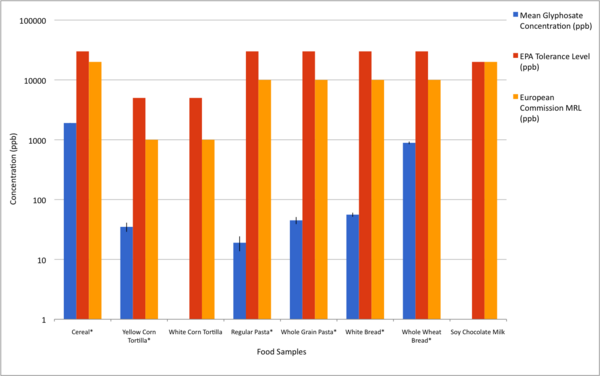Glyphosate Levels in American Food Products Meet Government Safety Levels Yet Exceed Concentrations Associated with Negative Effects
(1) Calabasas High School, Calabasas, California, (2) Ventura Community College, Ventura, California
https://doi.org/10.59720/18-071
Glyphosate, the active ingredient in the weed killer Roundup, is the most popular herbicide in the agricultural industry, with 6.1 billion kilograms sprayed worldwide in the past decade. Residue findings in breakfast foods and alcoholic beverages have prompted quantitative human and vertebrate studies yielding contradictory results . This study tested the hypothesis that glyphosate concentrations in frequently consumed food products exceed the levels legally allowed in Australia, the European Union, and the United States. The enzyme linked immunosorbent assay (ELISA) method was utilized to measure glyphosate concentrations in cereal, gluten-free white and yellow corn tortillas, regular and whole grain pasta, white and whole wheat bread, and soy chocolate milk. The results showed that mean glyphosate residues were the highest in cereal (1903 parts per billion [ppb]) and significantly higher in whole grain pasta (45 ppb) than regular pasta (19 ppb), in gluten-free yellow corn tortilla (35 ppb) than gluten-free white corn tortilla (none detected), and in whole wheat bread (888 ppb) than white bread (56 ppb). Mean glyphosate concentrations in 25% of samples exceeded the threshold (500 ppb) at which negative effects were observed in previous studies. However, glyphosate concentrations in none of the samples exceeded government-imposed limits. These results raise concerns about whether government-imposed limits are sufficient to protect human health. Future research should quantify glyphosate residues in a wider variety of foods and conduct epidemiological studies to reassess the sufficiency of current safety limits.
This article has been tagged with: